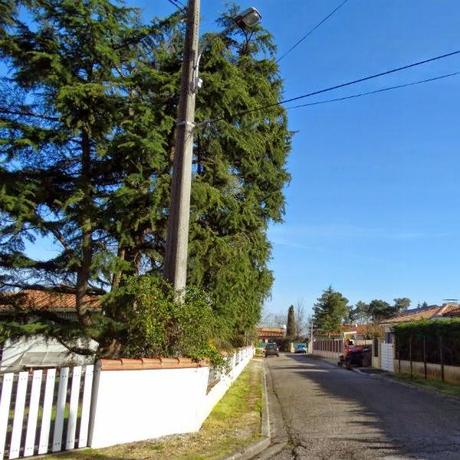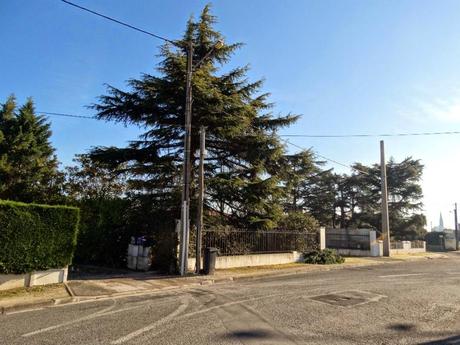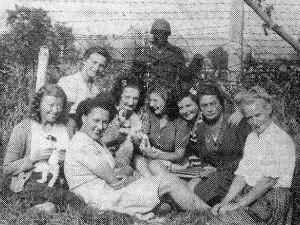 We are in a residential quarter in the suburb of Eysines, barely 300 metres from the town’s parish church. The unusual thing about the quiet neighbourhood is that it was the location of a camp which operated throughout the Second World War.
We are in a residential quarter in the suburb of Eysines, barely 300 metres from the town’s parish church. The unusual thing about the quiet neighbourhood is that it was the location of a camp which operated throughout the Second World War. The history of the camp is poorly documented. By far the most complete account I was able to find is on the Porte du Médoc website, where a chronological overview is coupled with some eye-witness testimonials. Sifting through the information available there and elsewhere, here are the basic facts.
The construction of the 21-barrack camp was initiated by the French State in 1939. The plans had been triggered by the outbreak of war and the camp was originally designed to house civilians who had been drafted in to work at the gunpowder factory in Saint-Médard-en-Jalles, a short train journey away. This explains the location of the camp, close to Eysines railway station (and therefore the Bordeaux-Lacanau railway line, which is now a popular cycle path that has already been featured on the blog).

What used to be Eysines railway station, now a private home.
When the June 1940 armistice was signed, the camp was still not complete and the Germans took over the project, hooking it up to the electrical grid and bringing in running water (nearby homes also benefited from the work). Meanwhile, the camp’s raison d’être shifted from gunpowder factory-workers (none of whom were ever based there) to other categories of tenants, the first of whom arrived during the late summer months of 1940.They were, in all likelihood, Spanish refugees followed closely by families who had been deported by the Germans from the Alsace-Lorraine region, and were now awaiting repatriation. They were free to come and go as they pleased and were protected by a small number of armed German soldiers. It is unclear what became of these refugees from the following winter onwards. Around that time, on the night of December 8th 1940, a number of Allied bombs fell nearby. It is thought that the camp may have been among the targets that night, along with Mérignac air base and the Port of Bordeaux.

The entrance to the camp was around this spot on Rue Déès. Note the spire of Eysines church in the distance.
Security at the camp then moved up a gear with the introduction of barbed wire fences and manned watchtowers ahead of the arrival of Senegalese troops, held within the camp and employed to build Atlantikwall bunkers and install telephone cables around Bordeaux, Blanquefort and Le Taillan. Details from then on are distinctly sketchy but around 1943, subsequent to Italy’s armistice with the Allies, most of the Italian marines based in Bordeaux switched their allegiance to Germany. Those who didn’t were held as prisoners of war and detained here in Eysines…
Source: Porte du Médoc,
full-size version here.
Finally, the camp was taken over by the Ministère des Colonies and became home to Indochinese (Vietnamese) workers who had initially been brought over to mainland France to provide extra manpower. Of France’s 27,000 wartime Indochinese immigrants, it is thought that 2,000 worked at the Saint-Médard gunpowder factory! Repatriation measures were long and drawn out and, from 1945 to 1946 and possibly 1947, many were lodged at the Eysines camp, receiving rations from the French State which caused much envy among the locals.
The Indochinese were the camp’s final residents and over the ensuing years the area developed into the residential quarter we can see today. It is said that nothing remains of the camp other than a small stretch of wall in a private garden! The main entrance to the camp on Rue du Déès is now someone’s driveway…

A reminder that the cycle path is not far away.
There is therefore little evidence to be uncovered of the wartime camp, which now appears to be little more than a footnote in the wartime history of the area; but for many individuals it surely formed the backdrop to what must have been a pivotal chapter in their lives.- Find it: the main entrance was near 4 Rue du Déès and the camp extended between Rues de Marne, du Vignan and Aladin Miqueau, Eysines; former Eysines railway station.
- Read the full story on Porte du Médoc here, and eye-witness testimonials here.
